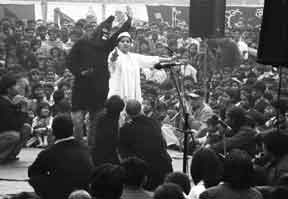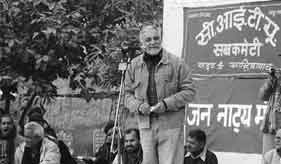 People's Democracy
People's Democracy
(Weekly
Organ of the Communist Party of India (Marxist)
No. 01
January 07, 2007
(Weekly
Organ of the Communist Party of India (Marxist)
|
Vol.
XXXI
No. 01 January 07, 2007 |
Safdar Hashmi Martyrdom Day Celebrated

A play in progress at Jhandapur village.
Arjun Ghosh
JANA Natya Manch and CITU jointly observed the Martyrdom Day of Comrade Safdar Hashmi. The programme was held on January 1, 2007 at the Ambedkar Park at Sahibabad. Thousands of people from across Ghaziabad and Delhi thronged the venue battling the unusually severe cold.
At the very beginning of the programme the artists of the Jana Natya Manch performed two revolutionary songs in homage to the martyrs. This was followed by the performance of a street play Ek Nayi Shuruwat (A New Beginning) by the Jana Natya Manch, Kurkshetra. The play depicted the effects of ever dropping sex ratio in states like Haryana. It also presents strong women characters who stand up against patriarchal strictures. A woman refuses to kill her unborn daughter. The opening sequences also dramatise a range of fields in which women have excelled in our society, albeit in certain cases been ahead of men. The main action of the play consists in the sexual assault on a college student. She is first stalked by a boy who, when she refuses to accept his attentions assaults her. The victim then receives support from the women members of her family against the father who tries to hush up the matter in order to protect family honour. They decide to have the matter tried before the panchayat. At every stage the women are threatened by the patriarchal forces. The assaulter’s family members threaten the women and even offer them money to withdraw the matter; then objections were raised against the participation of women in the panchayat proceedings. But the women stood up to all challenges and argued their case. The play ends on a positive note when some of the panchayat members begin to accept the women’s point of view. There have been many performances of the play, by various teams, across Haryana as part of the campaign. One remarkable factor about the play was the large number of women in the cast, some of them very young.
The next performance was of Rerhi Patri Nahi Hategi [Hawkers Won’t Go!] by Jana Natya Manch, Delhi. This play, too, was prepared as part of a campaign against the moves to remove hawkers and mobile shops from the streets and markets of Delhi. The play exposes the nexus between the local rich traders, the multinational corporations, the Congress government of Delhi and sections of judiciary. In fact, Rerhi Patri Nahi Hategi responded to a series of judicial interventions which sought to remove hawkers from Delhi. But as the opening sequence of the lay illustrates it is not that the life of hawkers was trouble free even before such orders were passed. It shows how the police would regularly use threat to collect money from the hawkers. But the hawkers were forced to continue for the sake of survival. The triumvirate – the rich trader, the MNCs and the judiciary – hatch a conspiracy to remove the hawkers to increase their control over the business potential of the city. They use the ruse of a campaign for ‘Clean Delhi, Green Delhi’. At the first go the hawkers are routed, and fail to resist with their individual efforts. It is then that they decide to organise and resist together to protect their right to earn a living.

Inderjit Singh addressing the Jhandapur meeting.
The next performance, also by Jana Natya Manch, Delhi, was of a play – Kafla Ab Chal Pada Hai – which was prepared on the occasion of the 25th anniversary of the formation of the All India Democratic Women’s Association (AIDWA). This play was actually a trilogy of three short scenes which depicted the heroism of the AIDWA activists across the country who were willing to even pay with their lives while fighting for progressive values and against corruption and exploitation. Lilavati an AIDWA activist in Tamil Nadu, raises her voice against the water mafia which thrives on the failure of the government to provide water to the people. Lilavati takes on the politicians who protect the water mafia and wins the Municipal elections. The politician-mafia nexus murders Lialavati, but fails to murder the will of the people who had been united by Lilavati. The mafia was ultimately defeated by the people. The other scenes dramatise similar heroism of AIDWA activists against the castiest forces who try to murder a young couple who have an inter-caste marriage; and against the efforts of terrorist groups in Tripura who try to terrorise tribal women to prevent them from uniting under the banner of the AIDWA. All the three stories are tied by the single idea that when women decide to organise and fight, they do not merely raise issues which are of concern to themselves but of tremendous significance for the entire society.
Act One group of Delhi performed Lal Zamin (Red Earth), a play which tried to relate the events of 1857 to the situation which prevails today. It identifies northern India as the focal point of the Revolt of 1857 and thus invigorates the people of the region to fight against the exploitative forces of today.
The main speaker of the meeting was Inderjit Singh, member of the CPI(M) Central Committee. In his speech Com. Inderjit pointed out various attacks on the rights of the working peoples across the world. He further spoke on the judicial assassination of former Iraqi president Saddam Hussein. He said that he was convinced that the people of Iraq are going to rise in a more vigorous resistance against the imperialist occupation. He analysed the recent incidents surrounding the horrendous discovery of human skeletons in NOIDA as an example where the poor and the weaker sections of the people stand completely vulnerable without any protection from either the law enforcement agencies or the government or the judiciary.
Like every year, this year too Janam held an informal gathering 'Safdar Ke Yaad Mein' on January 2, and a poetry reading session on January 3. On January 2, the main speaker was D Raghunandan of the Delhi Science Forum. He recounted a remarkable similarity between the formative years of the two organisations – the Jana Natya Manch and the Delhi Science Forum – both charting unexplored waters. Janam and the people’s science movement had to devise strategies to mobilse around issues and be creative in their intervention of issues such as the campaign against nuclear war, against the Bhopal Gas tragedy, or for secular values. He spoke at length about Safdar Hashmi’s ability to work with a non-sectarian mindset even while remaining strong in his own ideological commitment to progressive politics.
On January 3, a poetry reading session was held. In this poems by poets of the Middle-East were read out by the members of Janam and other participants